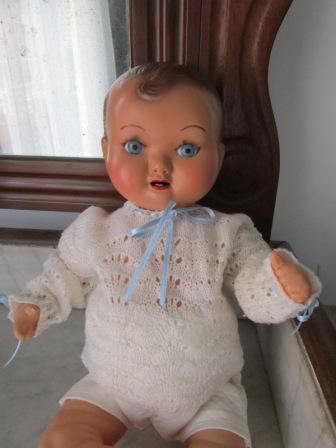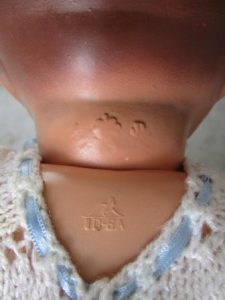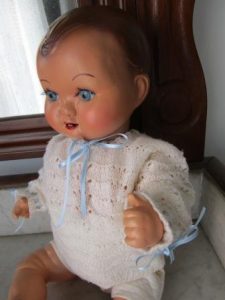All of the products on offer are selected according to quality criteria for materials and finishes. We always try to serve the piece with the maximum speed. We offer the possibility of personalised Restoration and/or Conservation quotations. Contact me for more information.
Antique Shop
Celluloid Agustí Parra Baby
95,00€
Celluloid Agustí Parra Baby. It has articulated head, arms and legs. The eyes are original, fixed and glass, vibrant facial coloration, ajar mouth, molded painted hair. This doll arrived in my hands in perfect condition only the rubbers have been changed. It measures about 45 cm.
It has a mark on the back of its neck with an A and a P. Mark attributed to Agustí Parra.
Brand Agustí Parra
Factory of Barcelona of 1931
To sum up, Agustí Parra registered a brand for making mainly celluloid dolls. In 1938 it registered a procedure to make celluloid wrists along with Juan Amadé and Serafín Jarque. They created dolls, babies and celluloid accessories. Interestingly, they made items for other workshops that made dolls that used the same items. In 1945 he registered a patent for a paste for the manufacture of dolls, same Celluloid Agustí Parra Baby. In 1948 he recorded dolls such as: Jorge, Betty Boop …
It has own models marked A (vine leaf) P
The Celluloid
In the last quarter of the 19th century, celluloid began to compete with traditional materials used in doll making, such as biscuit, wood, paper, and cloth.
Because it was a versatile substance, made from pyroxylin (cellulose nitrates) and camphor, it was an inexpensive material and easy to produce.
It was mostly used extensively for doll making, as well as many household items, until the mid-1950s, when it was replaced by other plastics.
Celluloid was first developed and used for Hyatt Brothers dolls in New Jersey in the late 1860s. His company registered the name “celluloid” in 1869. Although the product was patented, the word celluloid is used to Often to describe all types of pyroxylin mixtures, regardless of manufacturer.
The manufacturing process of the celluloid dolls in the first place is to place the celluloid substance in its solid state in a two-piece metal mold. The second step was to introduce steam or hot air into the mold under pressure, this softened the celluloid adapting to the shape of the mold until the two halves were joined.
When it cools, it is removed from the mold and the doll is decorated.
You May be Interested in…
Free shipping for orders over 60 € (peninsular Spain).
In stock
All shipments will be made in the Spanish Post Office providing the tracking number. The shipment can take between 2 and 8 weeks. Please note that the shipment may be delayed a little longer due to customs procedures in each country. Any possible tax or duty charges are the responsibility of the recipient. For more information on shipping countries and prices please refer to this page. The packaging will be protected with shock absorbing elements such as protective foam, bubble wrap and a cardboard packaging box. No exchanges, returns or cancellations are accepted.







